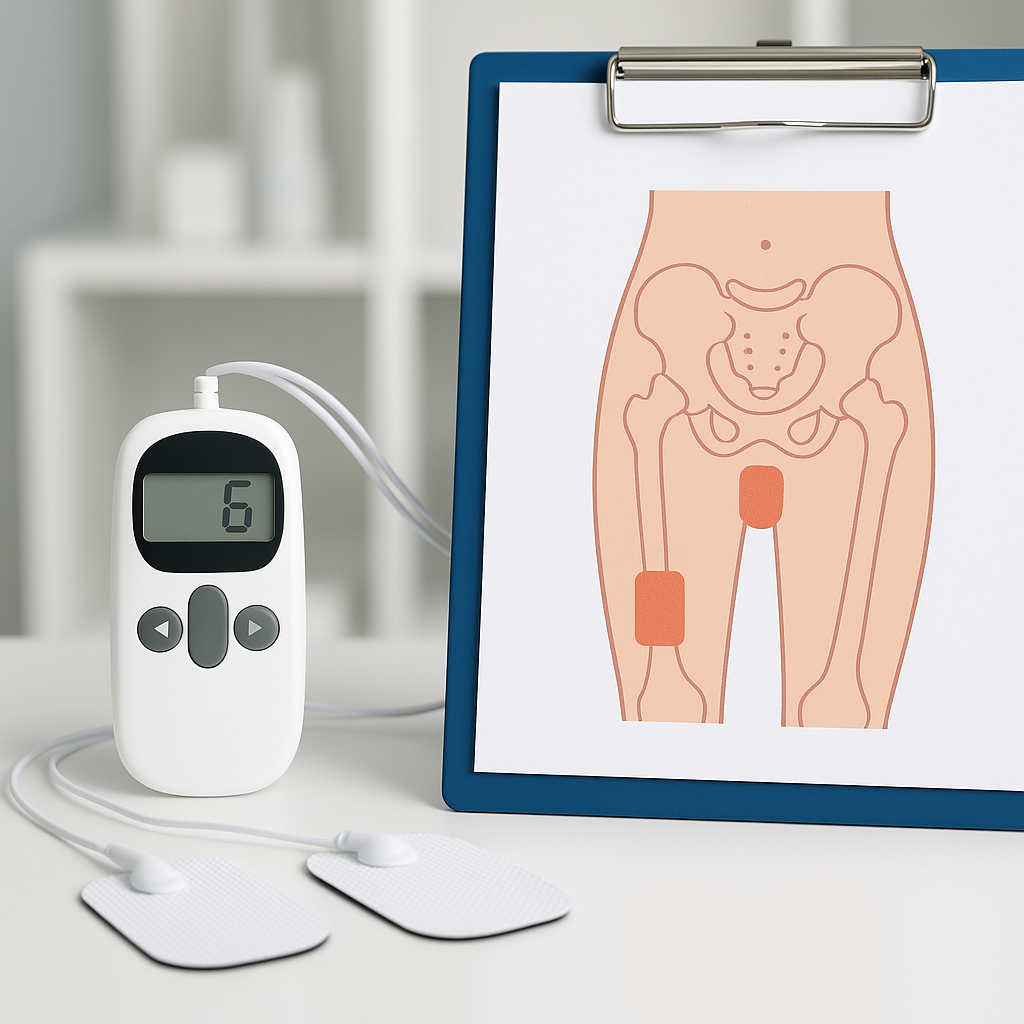Disclaimer
This content is for informational purposes only and should not be considered medical advice. Always consult a qualified healthcare professional before starting any treatment for erectile dysfunction or using a TENS device for therapeutic purposes.
Erectile dysfunction (ED) is a common issue that can affect men of all ages, often linked to nerve damage, poor blood circulation, or psychological factors. While oral medications like Viagra® and Cialis® remain the most prescribed treatments, some men explore non-invasive therapies like TENS (Transcutaneous Electrical Nerve Stimulation) as an alternative or supplementary method. This guide explains how TENS works for erectile dysfunction, where to correctly place the pads, and what precautions to take for safe and effective use.
What Is TENS Therapy?
TENS therapy involves sending mild electrical pulses through the skin to stimulate nerves and muscles. It’s a widely used technique in physiotherapy and pain management, but it’s now gaining attention for its potential role in improving sexual function. The low-frequency electrical impulses help activate muscles, increase blood flow, and enhance nerve communication—all essential elements for achieving and maintaining erections.
TENS units come as small, battery-operated devices with two or more electrode pads that you place on specific parts of the body. The placement of these pads determines which nerves and muscles are stimulated, making correct positioning essential for safety and effectiveness.
How TENS Helps With Erectile Dysfunction
Erectile dysfunction can result from various causes, including nerve injury, vascular insufficiency, hormonal imbalance, or even stress and anxiety. TENS primarily targets neurological and circulatory causes by improving nerve responsiveness and blood flow in the pelvic region. Here’s how it may help:
- Enhances pelvic blood circulation: The stimulation promotes vasodilation, which increases oxygen and nutrient delivery to penile tissues.
- Activates pelvic floor muscles: These muscles play a key role in maintaining an erection; electrical impulses help strengthen them.
- Stimulates nerve regeneration: Especially useful after surgeries like prostatectomy or nerve injuries from diabetes.
- Reduces stress signals: Low-frequency currents may help calm the nervous system, improving sexual arousal.
While TENS is not a miracle cure, it’s being studied as a complementary therapy for men who don’t respond well to medications or prefer non-drug interventions.
Correct Placement of TENS Pads for Erectile Dysfunction
When using TENS for ED, pad placement determines the success and safety of the therapy. The goal is to stimulate pelvic floor muscles and associated nerve pathways without causing discomfort or stimulating sensitive skin directly.
1. Perineal Region (Between Scrotum and Anus)
This area, known as the perineum, contains the bulbospongiosus and ischiocavernosus muscles, which help in achieving erections and ejaculation. Placing one pad here can help activate these muscles effectively.
How to place:
- Sit or lie down comfortably.
- Place one electrode gently on the skin between the scrotum and anus (not directly on the genitals).
- Use conductive gel for better adhesion and signal transfer.
2. Lower Abdomen (Above the Pubic Bone)
The pubic region houses nerve pathways associated with erectile function. Stimulation here can help improve blood flow toward the penile base.
How to place:
- Place one or two electrodes horizontally just above the pubic bone.
- Avoid direct contact with the genital area.
- Keep both pads at least one inch apart.
3. Inner Thigh (Close to Groin)
The inner thigh area, especially near the groin, targets branches of the pudendal and femoral nerves, which are involved in sexual function.
How to place:
- Position one pad on the upper inner thigh close to the groin but not on the genitals.
- If using two pads on each side, mirror placement symmetrically.
- Start with low intensity to prevent muscle twitching.
4. Lower Back (Sacral Nerve Region)
The sacral plexus (S2–S4) is the primary nerve group responsible for penile erection. Placing electrodes near the sacrum can stimulate this area safely.
How to place:
- Place two pads on the lower back, just above the tailbone.
- Ensure they’re aligned horizontally with a gap of 1–2 inches.
- Avoid spinal bone directly; aim for the soft tissue area.
Suggested Combinations
For optimal results, pair pad positions strategically, such as:
- One pad on the perineum and one on the lower abdomen
- One pad on each inner thigh
- Two pads across the lower back over sacral nerves
Always start at the lowest intensity setting, increasing gradually as your body adjusts. You should feel a mild tingling or pulsing sensation—not pain or muscle spasm.
How Often to Use TENS for Erectile Dysfunction
There is no one-size-fits-all frequency, but most protocols suggest 2–3 sessions per week for around 20–30 minutes each. Some users report improvements after 4–6 weeks of consistent use.
For mild cases or as maintenance therapy, once-weekly sessions may suffice. However, it’s best to consult a medical professional or physiotherapist for personalized guidance.
Precautions and Safety Tips
TENS therapy is generally safe when used properly, but misuse or incorrect pad placement can cause irritation or even nerve overstimulation. Follow these safety tips before starting:
- Never place pads on or near the penis or testicles. The skin there is too sensitive and can cause burns or nerve damage.
- Avoid using TENS if you have a pacemaker or any implanted electrical device.
- Do not use over open wounds, broken skin, or rashes.
- Start with low intensity. Gradually increase until you feel a gentle tingling.
- Clean the skin before and after sessions. It prevents irritation and improves conductivity.
- Stop immediately if you feel pain or discomfort.
- Consult your doctor if you have diabetes, cardiovascular issues, or nerve disorders before using TENS.
If you’re using TENS for ED recovery after surgery, especially prostate surgery, it’s critical to get professional instruction for pad placement to avoid interfering with healing tissue.
Expected Results and What Research Says
While TENS therapy for erectile dysfunction is not yet a standard clinical treatment, early studies show promising results. Research has found improvements in nerve sensitivity, erection hardness, and sexual satisfaction after several weeks of therapy in select groups.
- A 2019 pilot study on pelvic neuromodulation showed that electrical stimulation improved erectile response in men with mild ED.
- Another study on diabetic neuropathy indicated that low-frequency TENS improved penile nerve sensitivity and microcirculation.
- Post-prostatectomy rehabilitation programs sometimes include TENS or similar stimulation methods to accelerate nerve recovery.
However, the effectiveness varies depending on the cause of ED. Men with psychological or hormonal ED may see limited results compared to those with nerve-related causes.
Combining TENS With Other ED Treatments
TENS works best as a complementary therapy alongside other evidence-based treatments. Here are some combinations that may offer better results:
- Pelvic floor exercises (Kegels): Strengthening pelvic muscles can amplify TENS benefits.
- Lifestyle changes: Weight management, quitting smoking, and reducing alcohol can improve vascular health.
- Medication: Using prescribed ED medication occasionally can enhance confidence and help gauge progress.
- Counseling: If stress or anxiety plays a role, therapy can improve overall treatment response.
Always discuss any combination therapy with your healthcare provider before starting.
When to Avoid TENS for Erectile Dysfunction
Though TENS is safe for most men, there are situations where it’s best avoided. You should not use TENS if:
- You have a heart condition or use a pacemaker.
- You suffer from epilepsy or uncontrolled seizures.
- You have open sores or skin infections in the pelvic or thigh area.
- You experience unexplained pelvic pain that hasn’t been medically evaluated.
- You are using metal implants in the treatment area.
Consult your physician before beginning treatment, especially if you’re recovering from surgery or managing chronic health conditions.
Step-by-Step Guide for Safe Use
- Prepare the area: Clean the skin where you’ll place the pads with mild soap and water.
- Apply conductive gel: This ensures good contact and prevents irritation.
- Attach pads: Place electrodes in the selected regions as discussed.
- Turn on the device: Start at the lowest setting and slowly increase until you feel a comfortable tingling.
- Session duration: Keep the session to 20–30 minutes.
- Turn off and remove: Power off before detaching pads to avoid shocks.
- Clean and store: Wipe pads and store them in a cool, dry place.
Following these steps helps maximize effectiveness while minimizing side effects.
Can You Use TENS at Home?
Yes, you can safely use a TENS device at home after learning proper placement and safety precautions. Many portable units are available online or at pharmacies. Look for one that offers adjustable intensity, timer settings, and reusable pads.
Before starting home therapy:
- Have your first few sessions supervised by a physiotherapist if possible.
- Ensure you understand the correct pad placement.
- Keep track of how your body responds and report any unusual sensations to your doctor.
Final Thoughts
So, where do you put TENS pads for erectile dysfunction? The most effective and safe areas are the perineal region, lower abdomen, inner thighs, and lower back near the sacral nerves—never directly on the genitals. These placements target key muscles and nerves involved in erectile function while ensuring comfort and safety.
TENS therapy isn’t a replacement for medical treatment but can serve as a helpful, non-invasive complement to existing ED therapies. When combined with healthy lifestyle habits and professional guidance, it may help improve erectile function, confidence, and overall well-being.

